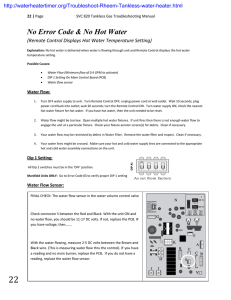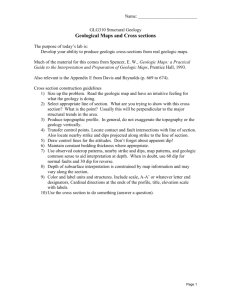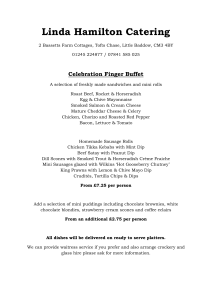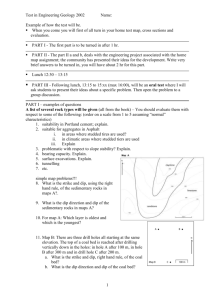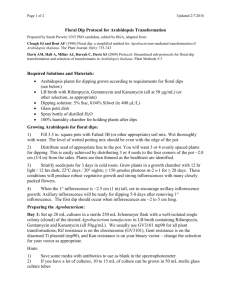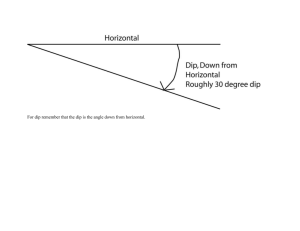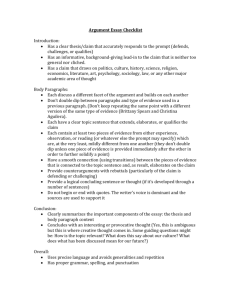Press Bulletin No. 154 Dipping Live Stock Agricultural Experiment Station
advertisement
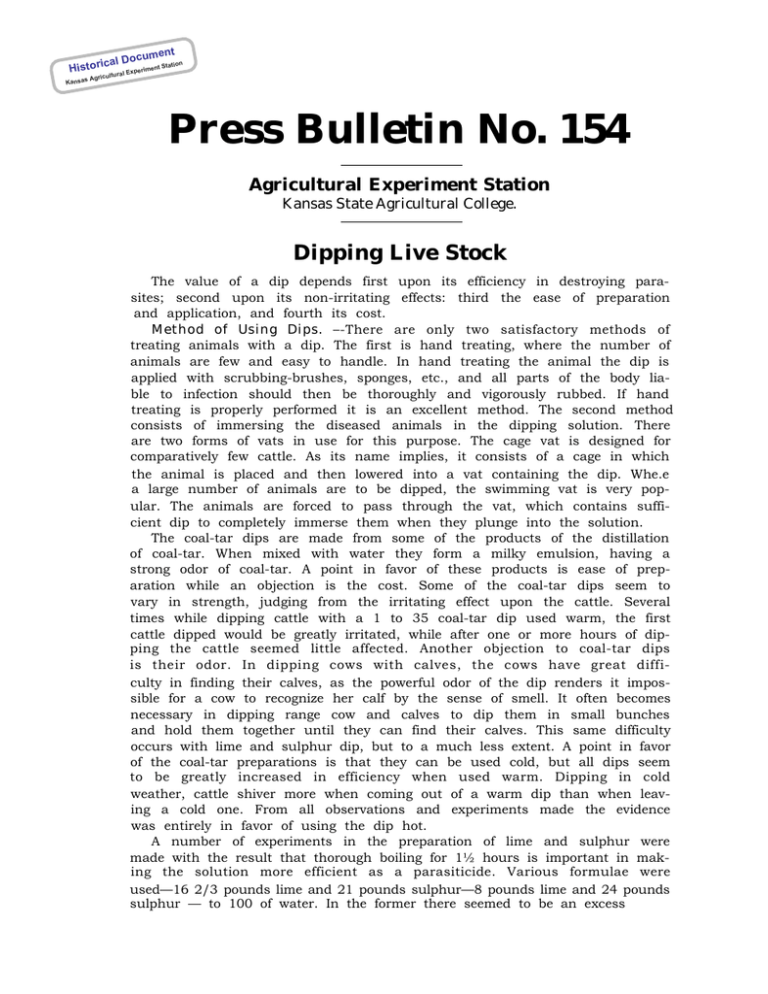
t cumen n io cal Do Histori tural Experiment Stat Kansas Agricul Press Bulletin No. 154 Agricultural Experiment Station Kansas State Agricultural College. Dipping Live Stock The value of a dip depends first upon its efficiency in destroying parasites; second upon its non-irritating effects: third the ease of preparation and application, and fourth its cost. Method of Using Dips. –-There are only two satisfactory methods of treating animals with a dip. The first is hand treating, where the number of animals are few and easy to handle. In hand treating the animal the dip is applied with scrubbing-brushes, sponges, etc., and all parts of the body liable to infection should then be thoroughly and vigorously rubbed. If hand treating is properly performed it is an excellent method. The second method consists of immersing the diseased animals in the dipping solution. There are two forms of vats in use for this purpose. The cage vat is designed for comparatively few cattle. As its name implies, it consists of a cage in which the animal is placed and then lowered into a vat containing the dip. Whe.e a large number of animals are to be dipped, the swimming vat is very popular. The animals are forced to pass through the vat, which contains sufficient dip to completely immerse them when they plunge into the solution. The coal-tar dips are made from some of the products of the distillation of coal-tar. When mixed with water they form a milky emulsion, having a strong odor of coal-tar. A point in favor of these products is ease of preparation while an objection is the cost. Some of the coal-tar dips seem to vary in strength, judging from the irritating effect upon the cattle. Several times while dipping cattle with a 1 to 35 coal-tar dip used warm, the first cattle dipped would be greatly irritated, while after one or more hours of dipping the cattle seemed little affected. Another objection to coal-tar dips is their odor. In dipping cows with calves, the cows have great difficulty in finding their calves, as the powerful odor of the dip renders it impossible for a cow to recognize her calf by the sense of smell. It often becomes necessary in dipping range cow and calves to dip them in small bunches and hold them together until they can find their calves. This same difficulty occurs with lime and sulphur dip, but to a much less extent. A point in favor of the coal-tar preparations is that they can be used cold, but all dips seem to be greatly increased in efficiency when used warm. Dipping in cold weather, cattle shiver more when coming out of a warm dip than when leaving a cold one. From all observations and experiments made the evidence was entirely in favor of using the dip hot. A number of experiments in the preparation of lime and sulphur were made with the result that thorough boiling for 1½ hours is important in making the solution more efficient as a parasiticide. Various formulae were used—16 2/3 pounds lime and 21 pounds sulphur—8 pounds lime and 24 pounds sulphur — to 100 of water. In the former there seemed to be an excess t cumen on cal Do Histori ural Experiment Stati Kansas Agricult of uncombined lime in the sediment, and in the latter an excess of sulphur, but in no cases did cattle show any bad results. In preparing the lime and sulphur dip, the lime and sulphur are placed in a kettle and 25 gallons of water added and boiled for the proper length of time, then allowed to settle for 48 hours. The surface liquid is drawn off and sufficient water added to make 100 gallons. This solution is then used at a temperature of 108° to 110° F. The cattle are kept in the dip for two minutes. Two dippings are generally advocated, 10 days apart. Cattle should be dipped in the fall and spring. One should avoid winter dipping, or when the weather is very hot in summer. Crude oil has recently been introduced to kill the Texas fever tick. A machine is equipped with a mechanical mixing device with which a perfect mixture of oil and water is obtained of oil one part and water four parts. This solution is forced through numerous pipes at a pressure of from 25 to 40 pounds. The spraying apparatus is so located that the application of the oil is from the rear, and consequently goes under the hair and penetrates the hide sufficiently to kill all parasites. This oil and water as supplied ought to be just as efficient in killing lice and the various mites of our domesticated animals as the coal-tar preparations or the lime and sulphur dip. The coal-tar preparations, in addition to being used as parasiticides, have become very popular disinfectants in hospitals. During the past two years large quantities of the following coal-tar preparations have been donated the Veterinary Department, K. S. A. C. — Zenoleum, Chloro-Naphtholeum, Kreso, Cremoline and Car-Sul. These preparations have been used with good success on all open wounds, where a disinfectant was indicated. In poll evil and fistulous withers they have been extremely valuable, owing to the fact that in addition to their power as a germicide they have been perfectly safe to place in the hands of persons not accustomed to handling drugs, because of their non-poisonous nature. They have been found quite efficient when used in 3 per cent solution, being much more valuable than carbolic acid of former years. The coal-tar products will not corrode the surgical instruments, although some of them mix better with water than others. Whenever any wood-work in the hospital needs disinfecting the coal-tar preparations are used rather than corrosive sublimate, the latter being so poisonous that it is not safe to use in the hospital from its liability to poison the patients. C. L. BA R N E S Manhattan, Kan., Feb. 19, 1907.
